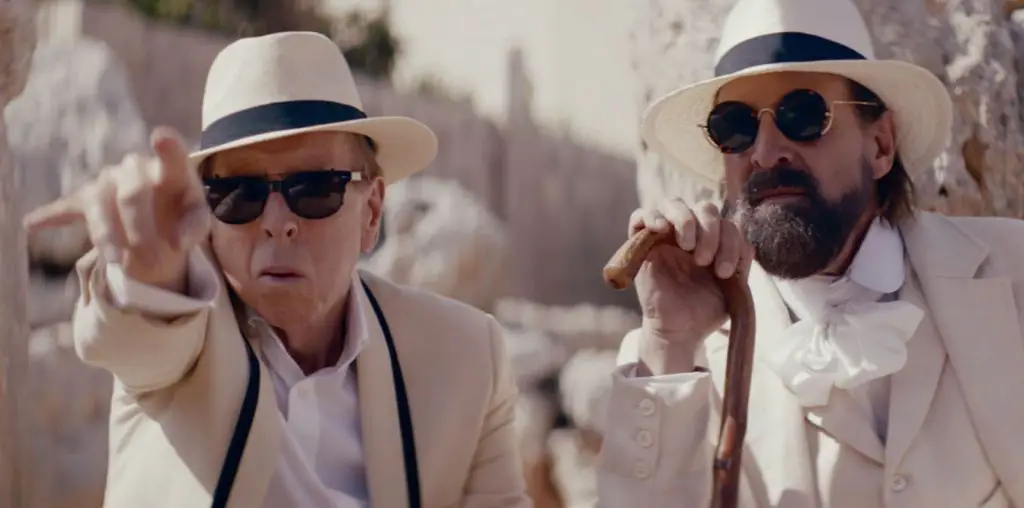
Remember that flamboyant, bug-eyed panelist from “Match Game” with the Elton John glasses, silk ties, and sailor’s cap? Maybe you caught the same seventies boob tube icon sitting across from Johnny Carson, during one of his 106 appearances on the “Tonight Show.” You know – the guy with three names. Aha! Charles Nelson Reilly! (Cue lascivious Reilly-patented giggle and the double-entendre of your choice.)
Like most people, you probably associate Reilly with this light, televised pop-culture fluff. Who knew he was a Tony-winning Broadway legend, or that the eccentric comedian had worked in film with director Elia Kazan (1957’s “A Face in the Crowd”)? “The Life of Reilly” exposes a popular artist’s less recognized – but perhaps more valuable – contributions to his craft. It also holds wrenching emotional power in its naked, warts-and-all history of one man’s life, spun into a monologue more riveting than all two hours and twenty-four minutes of “Transformers” overblown CGI chaos.
Based on a long-running, one-man stage act called “Save It For the Stage: The Life of Reilly,” this intimate expose by directors Barry Poltermann and Frank Anderson chronicles the show’s final performance in 2004. The movie serves as a tight distillation of Reilly’s enthusiastic concerts, which would typically last three to four hours per night (the film, in contrast, runs 89 minutes; an upcoming DVD version will feature the entire show).
Wearing an oversized, mint-green shirt pierced by a red Aids-Awareness ribbon, Reilly initially comes across as tiny and frail (he died on May 25th, 2007, of complications from pneumonia). Then, his lion-sized storytelling prowess takes over. Like a determined Hogwarts wizard, this energetic wordsmith conjures forth tale after mesmerizing tale from a sparse, prop-less stage. Reilly reveals an amazing ability to draw us into his past, through hand gestures and comforting descriptions of familiar locales. Oh, look – there’s the neighbor lady! Can you smell the rye bread?
Reilly churns up a chaotic, conflicted picture of his upbringing. The entertainer’s father turns down a promising career opportunity that permanently costs him his self-esteem. Later, Reilly Sr. would look for used bottles of high-priced whisky, put “fifty-five cent s**t” in the used containers, and stock them on the household shelves. Why? “So guests thought we could afford good liquor.” (And his mother? Uh, that’s another story too dark and complex to capture in a review.)
On June 6, 1944, a 13-year old Reilly narrowly escaped the harrowing Hartford Circus Fire, where 160 onlookers perished in the flames. “She lost her hair – and her mind,” Reilly remarks of an aunt who volunteered for lobotomy experiments. Christmas holidays were lonely, dismal events marked by his father drinking booze and breaking ornaments.
Despite these dire formative years, Reilly eventually found his salvation in acting, during the fifties. He reflects on attending thespian school with other future luminaries like Steve McQueen, Frank Langella, Jason Robards, and Jack Lemmon (whom he taught how to tie a tie). “We all had three things in common,” Reilly says of he and his classmates. “We wanted to be onstage, we had no money and we couldn’t act for s**t.”
Reilly ultimately won a place in the pantheon of television, stage, and film (recognized with two Tony Awards and multiple Emmy nominations). But it was a hard-earned victory. While he doesn’t overtly lament it, we learn that his homosexuality (seldom proclaimed, but often implied through subtle jokes during his T.V. appearances) cost him support both at home and amongst the network brass.
“A father doesn’t like to see his only son sewing dolls,” recalls Reilly, whose poor eyesight limited his childhood athletic abilities. Later, he describes an early, crucial job meeting with the President of NBC Television, describing the executive’s “beautiful desk,” and “gold cigarette lighter.” Then came the boss’ crushing proclamation that they didn’t let “queers” on television. “It was a very short interview,” summarizes Reilly, before a long, telling silence.
“The Life of Reilly” ultimately presents its resilient subject as an unusually optimistic force of nature. Despite these rejections, this survivor reached out to others for decades as a supportive acting coach, film actor, television performer and director, game show presence, talk show guest, and voice-over for children’s cartoons. The closing passages of his monologue echo forgiveness towards complicated family members, suggesting a wise insight into the contradictory shape of human nature. Enduring friendships with fellow actors like Burt Reynolds confirm both Reilly’s value of others, and the admiration his cronies felt for him.
Convinced that Robin Williams’ lit teacher in “Dead Poets’ Society” was the ultimate embodiment of “Seize the Day”? Did Rodney Dangerfield’s “Back to School” rendition of Dylan Thomas’ “Do Not Go Gentle Into That Goodnight” give you goose bumps? Then check out “The Life of Reilly,” for a real-life example of carpe diem energy too pure and unrefined to be silenced by discrimination or negative family vibes.

